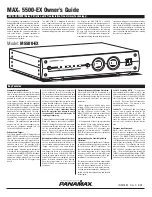
The Niagara 5000EU owner’s manual contains considerable information to ensure optimal performance, troubleshoot both common and
rare system interactions, and is a great primer to the technology that makes this unit so unique. However, we appreciate and respect your
valuable time. At the very least, we humbly ask that you follow this quick-start guide.
¡
¡
If the Niagara 5000EU has been exposed to excessive rain, flooding, fire, or has sustained considerable physical damage,
we ask that the unit be returned. Do not attempt to energize the unit or connect equipment to it!
¡
¡
The power source to which the Niagara 5000EU is connected should be 220-250VAC single phase nominal voltage, 16
amps (current capacity RMS). However, the Niagara 5000EU will operate very well with a 10-amp service outlet. For proper
operation, the Niagara 5000EU requires a safety ground (supplied via the power utility AC wall outlet).
¡
¡
The Niagara 5000EU may be placed on any table, cabinet, shelf, or floor. When rack-mounting is required, the four threaded
feet may be removed with a standard Phillips screwdriver.
¡
¡
Placement or proximity to other components is not critical, and, under standard use, the Niagara 5000EU does not produce
any appreciable heat.
¡
¡
Once the Niagara 5000EU is placed, an appropriate 16-amp-rated AC cord must be connected to the rear-panel AC inlet
(IEC-C20) connector. The AC cord must have an IEC-C19 female-end connector and a grounded male 230VAC Schuko
plug for use in EU, Russia, or other countries that require this outlet. For the best performance and proper Ground-Noise
Dissipation, we recommend AudioQuest AC cords.
¡
¡
High Current/Low-Z Power Banks: There are four High Current/Low-Z Power outlets (labeled “1,” “2,” “3,” and “4”). The
outlets feature our Transient Power Correction Technology, and are designed to enhance the performance of power
amplifiers via our circuit’s low-impedance transient current reservoir. Power amplifiers, monoblock amplifiers, integrated
amplifiers, powered receivers, or powered subwoofers should only be connected to these four outlets.
¡
¡
Power Correction Switch: This rear-panel-mounted switch MUST be set in the ENGAGE position, regardless of the
equipment (line-level, digital, video components, or power amplification) that is connected to the Niagara 5000EU. It may
not function properly otherwise. If necessary, see user manual set-up for more detailed information. (Otherwise, please
place this switch in the ENGAGE position.)
¡
¡
Ultra-Linear Noise-Dissipation System Power Banks: Typically, these are for all line-level, digital, and video products.
There are four banks (comprising outlet groups 5/6, 7/8, 9/10, and 11/12) that utilize this technology within the Niagara
5000EU. Further, each outlet group employs ground-noise isolation that is independent from the others.
¡
¡
I hear a slight buzzing sound coming from the Niagara 5000EU. Is it damaged? No, it’s not damaged (or, at least,
damage is very unlikely). If you’re in an extraordinarily quiet room and you hear this buzzing sound only when in relatively
close proximity to the Niagara 5000EU, or only when you place your ear next to the unit, the buzzing is normal and cannot
be entirely eliminated (though easily detectable levels are rare). See the Niagara 5000EU manual for detailed information
about high-level harmonic AC line distortion and its ability to make some of the circuits suffer from mechanical ringing, or
magnetostriction
.
¡
¡
Optimizing the polarity of the AC cords. For Schuko outlets, please use a male-pronged AC polarity-checking device
whenever possible. Plug this device into any of the Niagara 5000EU’s AC outlets. If the polarity-checking device shows
reversed polarity, reverse the AC cord supplying power to the Niagara 5000EU. However, as the Schuko outlets and plug
has no standard for polarity, the very best way to determine polarity is to try both connection orientations. Nevertheless,
one direction will always feature less noise, annoying grain or glare, and distortion. Select the better of the two plug
orientations for each cable, and then mark the plug and the outlet with a small sticker or pen mark that can be later
removed with isopropyl alcohol.
Quick-Start Guide
N
iagara
5000EU
Low-Z Power
|
Noise-Dissipation System













